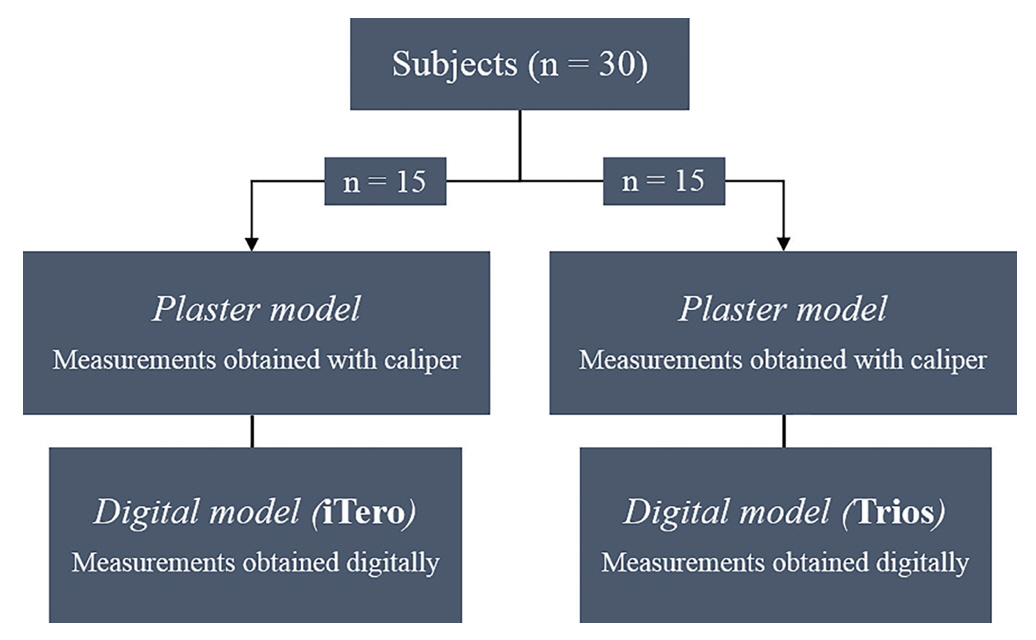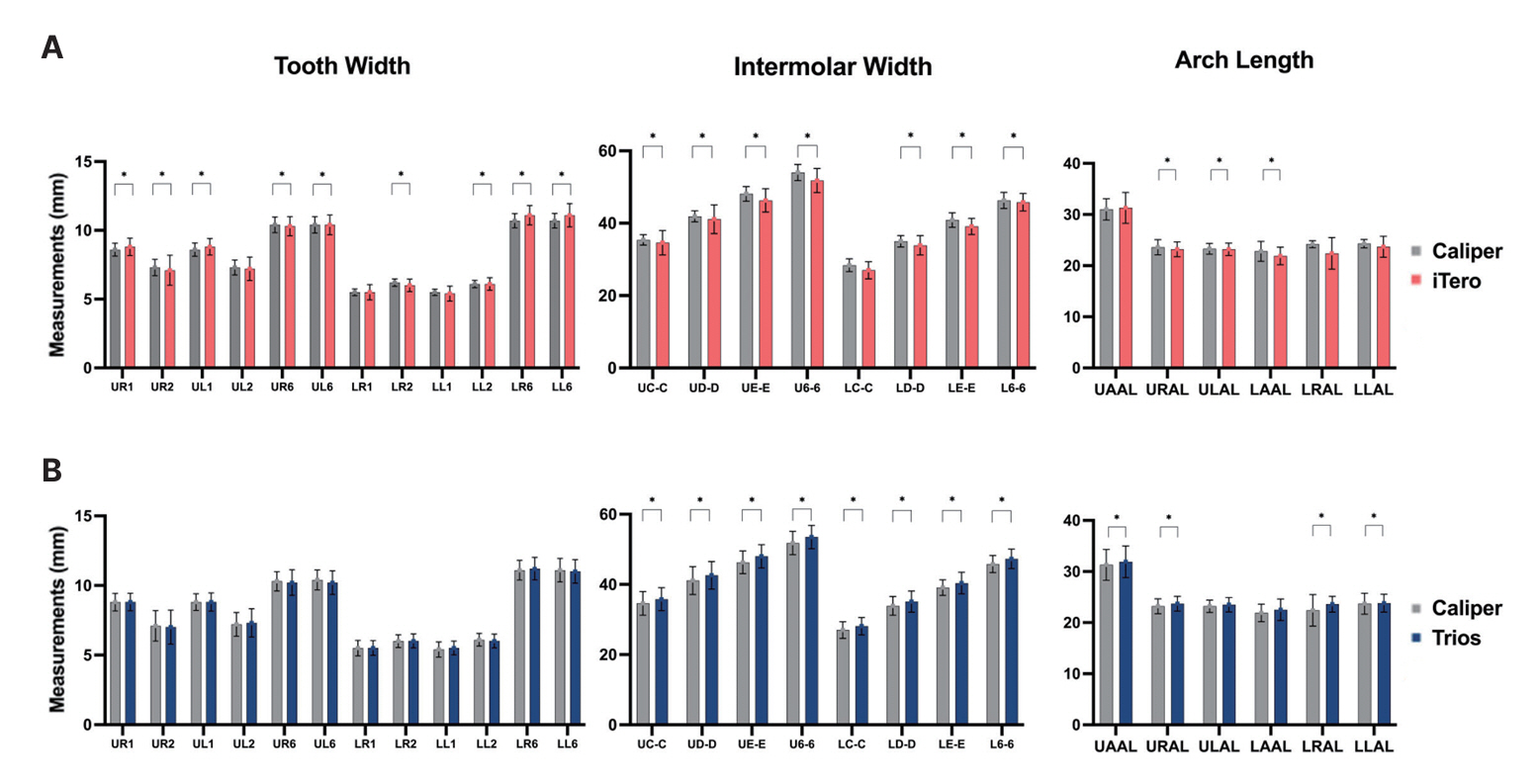 |
 |
| J Korean Acad Pediatr Dent > Volume 51(1); 2024 > Article |
|
Abstract
Fig 1.

Fig 2.

Fig 3.

Table 1.
| Caliper (mm) | iTero (ClinCheck Pro (mm)) | p value | |||
|---|---|---|---|---|---|
| Mean (SD) | Median (min - max) | Mean (SD) | Median (min - max) | ||
| UR1 | 8.6 (0.47) | 8.6 (7.6 - 9.4) | 8.8 (0.63) | 8.7 (7.7 - 9.8) | 0.012* |
| UR2 | 7.3 (0.59) | 7.4 (6.0 - 8.0) | 7.1 (1.10) | 7.2 (5.1 - 8.6) | 0.004* |
| UL1 | 8.6 (0.48) | 8.6 (7.6 - 9.5) | 8.8 (0.60) | 8.7 (7.5 - 9.8) | 0.006* |
| UL2 | 7.3 (0.54) | 7.5 (6.2 - 8.2) | 7.2 (0.85) | 7.1 (5.2 - 8.6) | 0.179 |
| UR6 | 10.4 (0.57) | 10.4 (9.2 - 11.1) | 10.3 (0.69) | 10.4 (9.0 - 11.7) | 0.001* |
| UL6 | 10.4 (0.59) | 10.4 (9.2 - 11.2) | 10.4 (0.72) | 10.3 (9.0 - 11.6) | 0.002* |
| LR1 | 5.5 (0.24) | 5.5 (5.0 - 5.9) | 5.5 (0.56) | 5.5 (4.5 - 6.2) | 0.285 |
| LR2 | 6.2 (0.27) | 6.2 (5.7 - 6.7) | 6.0 (0.46) | 6.0 (5.3 - 6.8) | 0.004* |
| LL1 | 5.5 (0.23) | 5.4 (5.3 - 6.0) | 5.4 (0.54) | 5.4 (4.3 - 6.3) | 0.073 |
| LL2 | 6.1 (0.27) | 6.1 (5.6 - 6.7) | 6.1 (0.45) | 6.1 (5.3 - 6.8) | 0.002* |
| LR6 | 10.7 (0.52) | 10.7 (9.9 - 11.5) | 11.1 (0.71) | 10.9 (9.4 - 12.4) | 0.047* |
| LL6 | 10.7 (0.53) | 10.8 (9.9 - 11.6) | 11.1 (0.84) | 10.8 (9.3 - 12.5) | 0.032* |
| UC-C | 35.4 (1.44) | 35.2 (33.2 - 38.4) | 34.6 (3.36) | 35.0 (27.7 - 39.8) | 0.031* |
| UD-D | 41.9 (1.51) | 41.4 (39.5 - 45.6) | 41.1 (3.97) | 41.6 (34.1 - 49.4) | 0.001* |
| UE-E | 48.1 (2.04) | 48.4 (44.7 - 53.0) | 46.3 (3.20) | 47.1 (39.8 - 51.5) | 0.001* |
| U6-6 | 54.0 (2.20) | 54.4 (50.4 - 59.3) | 51.8 (3.31) | 52.8 (46.2 - 56.2) | 0.001* |
| UAAL | 31.0 (2.08) | 30.2 (28.0 - 34.9) | 31.3 (3.01) | 30.1 (26.7 - 36.4) | 0.950 |
| URAL | 23.6 (1.47) | 24.1 (21.4 - 26.1) | 23.2 (1.44) | 22.5 (21.4 - 26.1) | 0.013* |
| ULAL | 23.3 (1.04) | 23.0 (21.8 - 25.6) | 23.2 (1.23) | 23.3 (21.4 - 25.7) | 0.029* |
| LC-C | 28.4 (1.76) | 28.8 (25.6 - 30.8) | 27.0 (2.36) | 27.1 (21.2 - 31.4) | 0.426 |
| LD-D | 35.0 (1.58) | 35.0 (32.5 -38.8) | 33.9 (2.66) | 34.0 (28.1 - 39.0) | 0.001* |
| LE-E | 40.9 (2.00) | 40.9 (38.5 - 45.3) | 39.1 (2.22) | 39.5 (34.2 - 42.4) | 0.001* |
| L6-6 | 46.3 (2.22) | 45.6 (42.9 - 51.4) | 45.8 (2.42) | 46.2 (41.8 - 50.6) | 0.001* |
| LAAL | 22.8 (1.95) | 22.3 (20.1 - 26.6) | 21.9 (1.72) | 21.9 (18.4 - 24.5) | 0.041* |
| LRAL | 24.2 (0.67) | 24.3 (22.8 - 25.2) | 22.4 (3.09) | 23.0 (12.8 - 26.6) | 0.426 |
| LLAL | 24.3 (0.83) | 24.1 (22.5 - 25.8) | 23.7 (2.04) | 23.4 (20.1 - 27.8) | 0.530 |
Wilcoxon-signed rank test.
UR1: Maxillary right central incisor; UR2: Maxillary right lateral incisor; UL1: Maxillary left central incisor; UL2: Maxillary left lateral incisor; UR6: Maxillary right first molar; UL6: Maxillary left first molar; LR1: Mandibular right central incisor; LR2: Mandibular right lateral incisor; LL1: Mandibular left central incisor; LL2: Mandibular left lateral incisor; LR6: Mandibular right first molar; LL6: Mandibular left first molar; UC-C: Primary maxillary canine to primary maxillary canine; UD-D: Primary maxillary first molar to primary maxillary first molar; UE-E: Primary maxillary second molar to primary maxillary second molar; U6-6: Permanent maxillary first molar to permanent maxillary first molar; LC-C: Primary mandibular canine to primary mandible canine; LD-D: Primary mandibular first molar to primary mandibular first molar; LE-E: Primary mandibular second molar to primary mandibular second molar; L6-6: Permanent mandibular first molar to permanent mandibular first molar; UAAL: Maxillary anterior arch length; URAL: Maxillary right arch length; ULAL: Maxillary left arch length; LAAL; Mandibular anterior arch length; LRAL: Mandibular right arch length; LLAL: Mandibular left arch length.
Table 2.
| Caliper (mm) | Trios (mm) | p value | |||
|---|---|---|---|---|---|
| Mean (SD) | Median (min - max) | Mean (SD) | Median (min - max) | ||
| UR1 | 8.8 (0.63) | 8.7 (7.7 - 9.8) | 8.8 (0.63) | 8.7 (7.8 - 10.0) | 0.873 |
| UR2 | 7.1 (1.10) | 7.2 (5.1 - 8.6) | 7.0 (1.22) | 7.5 (4.5 - 8.5) | 1.000 |
| UL1 | 8.8 (0.60) | 8.7 (7.5 - 9.8) | 8.8 (0.66) | 8.7 (7.7 - 10.0) | 0.401 |
| UL2 | 7.2 (0.85) | 7.1 (5.2 - 8.6) | 7.3 (1.02) | 7.3 (5.7 - 8.8) | 0.528 |
| UR6 | 10.3 (0.69) | 10.4 (9.0 - 11.7) | 10.2 (0.92) | 9.9 (8.7 - 12.0) | 0.157 |
| UL6 | 10.4 (0.72) | 10.3 (9.0 - 11.6) | 10.2 (0.85) | 10.2 (8.8 - 11.7) | 0.113 |
| LR1 | 5.5 (0.56) | 5.5 (4.5 - 6.2) | 5.5 (0.53) | 5.6 (4.6 - 6.2) | 0.756 |
| LR2 | 6.0 (0.46) | 6.0 (5.3 - 6.8) | 6.0 (0.50) | 6.2 (5.2 - 6.9) | 0.526 |
| LL1 | 5.4 (0.54) | 5.4 (4.3 - 6.3) | 5.5 (0.49) | 5.5 (4.7 - 6.4) | 0.530 |
| LL2 | 6.1 (0.45) | 6.1 (5.3 - 6.8) | 6.0 (0.49) | 6.1 (5.3 - 6.8) | 0.755 |
| LR6 | 11.1 (0.71) | 10.9 (9.4 - 12.4) | 11.2 (0.80) | 11.0 (9.9 - 12.7) | 0.394 |
| LL6 | 11.1 (0.84) | 10.8 (9.3 - 12.5) | 11.0 (0.84) | 10.7 (9.5 - 12.5) | 0.422 |
| UC-C | 34.6 (3.36) | 35.0 (27.7 - 39.8) | 35.8 (3.29) | 36.3 (31.0 - 41.4) | 0.001* |
| UD-D | 41.1 (3.97) | 41.6 (34.1 - 49.4) | 42.6 (3.92) | 43.0 (35.6 - 50.5) | 0.001* |
| UE-E | 46.3 (3.20) | 47.1 (39.8 - 51.5) | 48.0 (3.32) | 48.6 (41.9 - 52.3) | 0.001* |
| U6-6 | 51.8 (3.31) | 52.8 (46.2 - 56.2) | 53.5 (3.32) | 54.9 (47.2 - 58.4) | 0.001* |
| UAAL | 31.3 (3.01) | 30.1 (26.7 - 36.4) | 31.9 (3.08) | 30.7 (28.2 - 38.2) | 0.027* |
| URAL | 23.2 (1.44) | 22.5 (21.4 - 26.1) | 23.7 (1.45) | 23.1 (21.6 - 26.4) | 0.007* |
| ULAL | 23.2 (1.23) | 23.3 (21.4 - 25.7) | 23.5 (1.43) | 23.4 (21.2 - 26.0) | 0.078 |
| LC-C | 27.0 (2.36) | 27.1 (21.2 - 31.4) | 28.1 (2.47) | 28.4 (21.6 - 31.4) | 0.001* |
| LD-D | 33.9 (2.66) | 34.0 (28.1 - 39.0) | 35.1 (3.04) | 35.7 (27.9 - 39.4) | 0.001* |
| LE-E | 39.1 (2.22) | 39.5 (34.2 - 42.4) | 40.4 (3.09) | 41.2 (34.2 - 45.5) | 0.007* |
| L6-6 | 45.8 (2.42) | 46.2 (41.8 - 50.6) | 47.3 (2.78) | 47.6 (42.2 - 53.3) | 0.001* |
| LAAL | 21.9 (1.72) | 21.9 (18.4 - 24.5) | 22.5 (2.10) | 22.8 (17.7 - 25.1) | 0.083 |
| LRAL | 22.4 (3.09) | 23.0 (12.8 - 26.6) | 23.6 (1.56) | 23.9 (20.5 - 26.6) | 0.003* |
| LLAL | 23.7 (2.04) | 23.4 (20.1 - 27.8) | 23.8 (1.74) | 23.9 (20.2 - 26.6) | 0.047* |
Wilcoxon-signed rank test.
UR1: Maxillary right central incisor; UR2: Maxillary right lateral incisor; UL1: Maxillary left central incisor; UL2: Maxillary left lateral incisor; UR6: Maxillary right first molar; UL6: Maxillary left first molar; LR1: Mandibular right central incisor; LR2: Mandibular right lateral incisor; LL1: Mandibular left central incisor; LL2: Mandibular left lateral incisor; LR6: Mandibular right first molar; LL6: Mandibular left first molar; UC-C: Primary maxillary canine to primary maxillary canine; UD-D: Primary maxillary first molar to primary maxillary first molar; UE-E: Primary maxillary second molar to primary maxillary second molar; U6-6: Permanent maxillary first molar to permanent maxillary first molar; LC-C: Primary mandibular canine to primary mandible canine; LD-D: Primary mandibular first molar to primary mandibular first molar; LE-E: Primary mandibular second molar to primary mandibular second molar; L6-6: Permanent mandibular first molar to permanent mandibular first molar; UAAL: Maxillary anterior arch length; URAL: Maxillary right arch length; ULAL: Maxillary left arch length; LAAL; Mandibular anterior arch length; LRAL: Mandibular right arch length; LLAL: Mandibular left arch length.
References
- TOOLS
-
METRICS

-
- 0 Crossref
- 0 Scopus
- 28 View
- 21 Download
- ORCID iDs
-
Seo Young Shin

https://orcid.org/0000-0002-3651-9635Yong Kwon Chae

https://orcid.org/0000-0001-8059-9305Ko Eun Lee

https://orcid.org/0000-0002-5641-4443Mi Sun Kim

https://orcid.org/0000-0001-8338-1838Ok Hyung Nam

https://orcid.org/0000-0002-6386-803XHyo-seol Lee

https://orcid.org/0000-0001-7287-5082Sung Chul Choi

https://orcid.org/0000-0001-7221-2000 - Related articles



 PDF Links
PDF Links PubReader
PubReader ePub Link
ePub Link Full text via DOI
Full text via DOI Download Citation
Download Citation Print
Print



